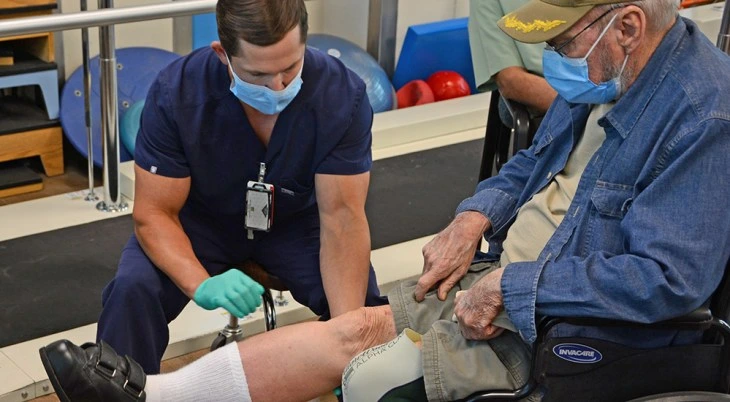Amputation is the loss or severing of a body part, such as a finger, arm, or leg. Amputation can occur as a result of an injury, or it can be part of a surgical procedure to remove a body part to treat a condition or disease.
Amputation due to injury can occur partially (partial) or completely (total). Partial amputation means that there is still some or some soft tissue connected so that the patient’s body part is not completely severed. While in total amputation, the patient’s body part is completely severed.
In both partial and total amputations, the possibility of the severed body part being reattached or not depends on the severity of the injury itself. If the severed body part cannot be reattached, the patient will be advised to use a prosthetic leg or hand.
The term amputation is also used for the procedure of cutting off a body part to prevent a more dangerous condition. The dangerous conditions referred to include the spread of infection, rotting wounds (gangrene), and cancer.
Causes of Amputation
Amputation can occur due to serious accidental injury, or it can be planned by a doctor to treat a number of diseases. Here is the explanation:
Amputation due to injury
Amputations caused by injury can occur due to a number of the following conditions:
- Natural disasters, for example being hit by building debris during an earthquake
- Work-related accidents involving machinery or heavy equipment
- Motor vehicle accident
- Wild animal attack
- Severe burns
- Gunshot wound
Amputation due to disease
There are many diseases that can require someone to undergo an amputation procedure, including:
- Thickening of nerve tissue (neuroma)
- Frostbite or injury due to exposure to extreme cold temperatures
- Severe infections in the arms or legs, for example bone infections (osteomyelitis) or severe necrotising fasciitis
- Cancer, such as osteosarcoma or cancer that spreads to the bones, muscles, nerves, and blood vessels
- Gangrene, for example due to peripheral arterial disease or diabetic neuropathy
Symptoms of Amputation
Symptoms of amputation that can be experienced, especially in amputations due to injury, include:
- Pain, the level of which is not always proportional to the severity of the injury or bleeding.
- Bleeding, the severity of which depends on the location and type of injury sustained.
- Body tissue is damaged, but some tissue is still connected to muscles, bones, joints, and skin, or is completely severed.
When to see a doctor
Seek immediate medical attention from a doctor if you experience an amputation due to injury. Although severed organs cannot necessarily be reattached, amputation wounds can cause severe bleeding and infection. Sufferers can also die if not treated immediately.
Have regular check-ups with your doctor if you have a disease that could cause you to have to undergo an amputation procedure if not treated properly, such as diabetes or peripheral artery disease.
For those of you who have undergone an amputation procedure, do regular check-ups with your doctor. In addition to undergoing rehabilitation therapy to improve your ability to do activities, regular check-ups with your doctor also aim to prevent and detect complications that may arise after an amputation.
Contact your doctor immediately if you experience the following symptoms after undergoing an amputation procedure:
- Stitches in the open amputation area
- Fever or chills
- Pain in or around the amputation area
- Swelling, redness, or bleeding at the amputation area
- Discharge of fluid, blood, or pus from the amputation area
Amputation Diagnosis
Diagnosis of amputation begins with questions and answers about how the amputation occurred, history of injuries, and history of other diseases or conditions. Usually, a doctor can immediately diagnose an amputation by directly examining the severed organ.
Sometimes, doctors need to take X-rays to check the condition of the bones and tissues around the amputation site. Doctors can also do supporting examinations in the form of blood tests , including blood sugar tests to detect diabetes.
Amputation Treatment
Amputation treatment must be done in a hospital. If the amputation has just been done and there is heavy bleeding, the doctor will first stop the bleeding. After that, the doctor will give an IV fluid and blood transfusion to stabilize the patient’s condition.
In some cases, severed body parts can be reattached with a replantation procedure. Replantation is performed when the body part to be reattached is not severely damaged and is expected to function well after replantation.
If both of the above factors are not met, then replantation will not be performed. For patients who cannot undergo replantation, the doctor will recommend the use of a prosthesis. In some cases, a prosthesis can replace the function of a lost body part well.
Recovery after amputation
Permanent loss of a limb due to amputation can reduce self-confidence and reduce the patient’s ability to function. To overcome this problem, doctors will recommend that patients undergo regular physical rehabilitation.
The rehabilitation carried out includes:
- Exercises to increase muscle strength
- Exercises to improve limb mobility skills, so that patients can carry out activities independently.
- Treatment and care to support recovery and relieve pain that occurs in the amputation area.
- Psychological therapy to overcome emotional disturbances that may be experienced by patients due to the loss of body organs.
- Use of assistive devices, such as wheelchairs and crutches
Complications of Amputation
There are several complications that may occur after amputation, namely:
- Painful
- Bleeding
- Swelling (edema)
- Infection
- The joints, muscles, and tendons around the missing organ become stiff and difficult to move.
- Phantom limb, which is a painful sensation that appears in a missing body organ.
- Mental disorders, such as post-traumatic stress disorder (PTSD), irritability, depression, and suicidal thoughts
- Deep vein thrombosis (DVT)
- Heart attack
- Pneumonia
- Shock
Amputation Prevention
Amputations due to injury usually occur suddenly and unexpectedly, making them difficult to prevent. Meanwhile, efforts that can be made to avoid amputations due to disease are by preventing the disease from occurring.
For example, amputations due to peripheral artery disease and diabetes can be prevented by quitting smoking, eating a healthy and balanced diet, and exercising regularly.
Some other ways that can be done to avoid amputation are:
- Prevent foot ulcers if you have diabetes, as ulcers can increase the risk of amputation.
- Use personal protective equipment, both when driving and working, especially if your job involves using heavy equipment.
- Always be careful and obey traffic signs when driving to avoid accidents.
Source :
Williams, B., et al. (2021). Characteristics and Outcomes of Human and Animal Bites in Malawi. Injury, 52(8), pp. 2188–93.
Chung, K., et al. (2019). Patient-Reported and Functional Outcomes after Revision Amputation and Replantation of Digit Amputations: The FRANCHISE Multicenter International Retrospective Cohort Study. JAMA Surgery, 154(7), pp. 637–46.
Health Direct (2020). Health Topics A–Z. Amputation.
National Health Service (2019). Health A to Z. Amputation.
National Institutes of Health (2020). MedlinePlus. Leg or Foot Amputation.
National Institutes of Health (2020). MedlinePlus. Traumatic Amputation.
Johns Hopkins Medicine (2021). Treatments, Tests, and Therapies. Amputation.
Cleveland Clinic (2021). Treatments & Procedures. Amputation.
Mayo Clinic (2020). Diseases & Conditions. Amputation and Diabetes: How to Protect Your Feet.
Drugs (2022). Toe Amputation.
Dunkin, M. WebMD (2022). Amputation Overview.
Nall, R. Healthline (2022). Amputation: Causes, Statistics, and Your Most-Asked Questions.

